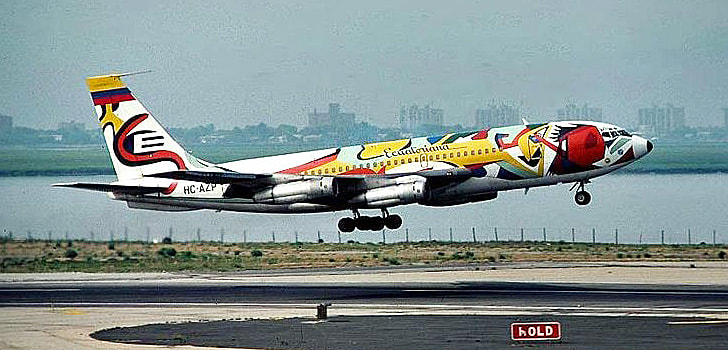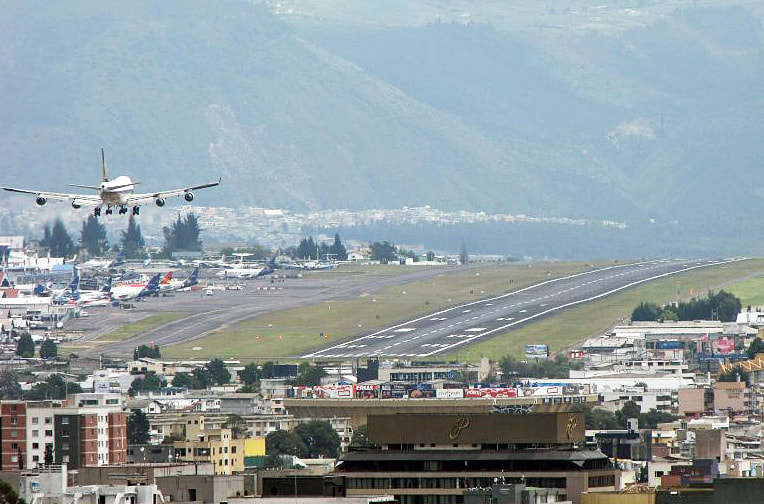We lost the engine
By Capt. Fernando de la Torre Bekdach
|
It must have been the spring of 1983, the FAA authority and the Department of Transportation of USA laid restrictions on noise in airports and their surroundings by installing anti-noise sensors to measure the decibels produced by aircraft, the P&W JT3B-3D engines that we used in our B707s for the company Ecuatoriana de Aviacion did not meet these parameters, it was no longer possible to take off at night back to Ecuador as the itineraries had been for a long time, it had to be done early in the morning until the company meets the requirement and install the noise suppressors or "Hush Kits."
One of those flights was on a Sunday that spring of 1983 returning from New York Kennedy (KJFK) to Guayaquil (SEGU) and final destination the old airport of Quito (SEQU), a distance of 2580 nm, flight time 06:00 hours approximately, flying with sunlight on that route was very beautiful, we were able to see the entire east coast of the US, all the way to Norfolk, we could see cities like Atlantic City, Washington DC, Baltimore and Philadelphia before reaching the route AR23 that took us through the Atlantic Ocean to the island of Freeport in the Bahamas, then the Caribbean, Cuba, west of Jamaica, Panama, the Pacific Ocean to Esmeraldas Ecuador and the descent overland to Guayaquil. From what we always flew at night, flying during the day was marvelous. Usually, the KJFK returns on Sundays were full aircraft; we took off very heavy, fuel consumption in the B707 was 14,000 Lbs. Per hour approximately, 6 hours of flight time 84,000 Lbs. or 12,500 gallons plus 16,000 Lbs. for the reserve, which was the fuel policy of the company, fuel at takeoff 100,000 Lbs. that meant full wings and 9,000 lbs. in the central tank plus the payload, passengers, luggage and cargo about 33,000 lbs. total takeoff weight 280,000 lbs. Kennedy airport at that time on Sundays was extra congested; we had to be super punctual for start-up, backtracking, taxiing, and takeoff. Ecuatoriana used the Pan American World Airways terminal (now defunct). They made the dispatch, weight, and balance; they gave us the meteorological folder and the flight plan. Usually, the takeoff was from runway 31L, an extra-long runway, SID Kennedy Five Departure, left turn, initial climb to 5000 feet with vectors to the airway, at that time the B707s had practically primary navigation and installed some Omega systems that helped us roughly. The two pilots, the Captain and the Copilot were former Air Force officers; I had a minimal affinity with them, they practically did not speak to me much, most likely technical things, the flight up to NYC they only talked about when they were in the Air Force (FAE) and from a lot of characters of that institution and as when they were cadets they received all kinds of abuses from the oldest and later they did the same with more seniority, the Commander was the Technical Vice President of the company. We usually climbed to our initial cruising altitude, FL350. At the same time, level and approaching Norfolk VOR, engine three low oil pressure light came on and started flashing; it meant that the engine oil filter became clogged and has taken the alternate route (bypass), the engine continued to be lubricated, the Commander asked me, "what do we do in this case," I informed him that the procedure after reading the alternate procedures checklist is to reduce engine power gradually if the light disappears, maintain that power and the process finished. Still, it didn't happen, and the throttle lever reached idle; now we had the red light steady, the Commander asked me what to do in this situation, the checklist ordered to shut down the engine immediately. The B707 generators in the electrical system had what it was called essential. As the electrical system was built in engine three, I informed the Commander it was necessary to change from engine three to engine two. While doing this procedure, the Automatic Pilot was lost momentarily; once the transfer was made, the AP engaged, the engine shut down, and the procedure finished. The Commander stabilized the aircraft with the rudder trim, and that's it. I immediately informed the pilots that we were too heavy. We could not maintain the level. We should initially descend to FL 290; the co-pilot, who was a bit intransigent, began to question the level, the Captain accepts my criteria. They requested to descend to FL290, ATC authorized us; I took out the performance charts for three engines for descending and cruise, I informed them of the procedure. We could not reach our destination; the Commander decided to proceed to Miami, where the company had offices and maintenance personnel. After talking with ATC, the flight plan was changed. They gave us another route so as not to enter the sea. Once the flight plan to our new destination Miami (KMIA), had been updated, I did the calculations for the landing, and we were overweight; I inform the Captain, he told me to do the calculations to dump fuel (fuel dumping) to reach the required weight for landing. Through the HF radio, I contacted operation offices in Quito, code Y99 on frequency 11236, luckily there wasn't much static, and communication was right; I informed them of the problem and that they contact the office in Miami to receive us and to coordinate maintenance and possibly the passengers and crew to the hotel. Likewise, I communicate with ARINC in HF, an American company that gives us communication services; I informed them of the problem and contacted our office in Miami. While doing the calculations to dump the fuel (dumping) I saw that it is not too much to "dump", I informed the Captain, I suggested that we should request a lower level to burn fuel and reach the desired weight for landing, again the co-pilot questions my suggestion, I explain to them that it is the best since we don't have to do a whole procedure when we were close to the approach at low altitude, reducing the speed to be able to lower the dump shuts where the fuel comes out that have a speed limitation and again accelerate to get enough pressure for the fuel to come out, the Captain accepts my suggestion and they requested a lower level, we initially descended to FL180 and effectively the fuel consumption increased considerably, we continued the flight, the briefing was done to land three engines and in a few more minutes we were on the ground, we taxied in to a remote position, the passengers stayed on board, the technicians arrived to check the engine, the engine canopies were opened and in fact nothing was seen since the problem was in the oil filter, the Commander accepts maintenance criteria that everything is fine and that we could continue with the flight. - "Where a Captain rules, a sailor has no sway"- Captain's decision is final, and we can't disagree with him, a new flight plan was filed to Guayaquil (SEGU), we needed to upload some fuel, and we were underway. We started engines, engine three was all normal, there is no low-pressure light, and the Commander says that the "gringos" referring to the technicians who checked the engine know what they are doing, and he trusted them. We took off from runway 12 SID Miami 5, initial climb to 5000 feet, radar vectors to the airway; we climbed towards "Ursus" position to continue with our flight plan southbound to Guayaquil, at approximately 15,000 feet "PUM" the low-pressure light for engine three comes on, this time is steady, not flashing, I inform the Commander that we have to reduce power to idle and most likely shut down the engine and return to Miami. To my surprise, the Commander says that nothing happens, that he trusts the technicians in Miami and that it must be a failure of the sensor of the oil pressure transmitter in the filter; he extended his hand, removed a cover of the RED light, and took out the bulb that was on, puts the cap back on and says ready, fixed the problem and that the "babalus" (nickname) technicians from the Israeli company IAI (Israel Aircraft Industries) who give us maintenance, will solve the sensor problem in Quito. We continued the flight with four engines, made the approach in Guayaquil, landed. While taxing into the terminal, the Commander inserts the bulb to check if the problem continued, the light turns on, nothing had changed, we disembarked passengers, flight plan to Quito, again without the light bulb, took off, climbed, descent to Quito and landing, end of the flight, passengers and crew to their homes, maintenance took over, engine check, after borescope inspection the engine is burned out due to lack of lubrication and must be changed. THE ENGINE IS GONE, no action against the Commander. The question: If he had not been a senior executive, would he have been sanctioned or drawn to attention? Note: Losing an engine in an aircraft that has four engines is not a problem; if two are lost, the aircraft will potentially fly at a lower altitude and will perform better at lower weights, as per manual the approach has to be made in VMC. Capt. Fernando de la Torre Bekdach (retired). |
Me as F/O at the helm of Ecuatoriana Airlines Boeing 707-321B HC-BHY in 1990.
Ecuatoriana Boeing 720-023B HC-AZP is seen here blasting out of JFK Airport on a dull day in July 1976.
Photo credit: Ken Rose Boeing 720-023B HC-AZO, taxying out at Miami, bound for Guayaquil, in April 1977.
Photo credit: Fredy. Boeing 720-023B HC-AZP smoking out of Bogota-El Dorado in the late '70s.
Photo credit: via Capt. Fernando. Old Quito Mariscal Sucre Airport (near the top of the image) spotted from a KLM MD-11 on approach to it in 2010.
Photo credit: Ssr. To land in Quito old city airport, was a spectacular but sometimes frightening high-altitude experience. Even routine flyers were jarred by the sudden appearance of high-rise buildings through common late-afternoon clouds as the plane plunged down over the city center for a pinpoint landing, as pictured above.
Photo credit: unknown. In the 1970s, most South American national airlines were operated by national air forces. Through the Defence Ministry, the Ecuadorian Air Force bought two refurbished Boeing 707s for the airline from Israeli Aircraft Industries in a deal worth US$4,700,000 (equivalent to $24,365,789 in 2019) million.
A Cargolux Boeing 747-freighter is seen landing on old Quito international airport, Ecuador.
Photo credit: Bstar. |
If you enjoyed this story and you want to publish your own aviation memoires, do not hesitate and contact me at [email protected].








